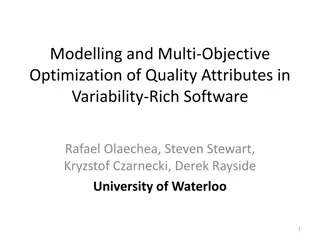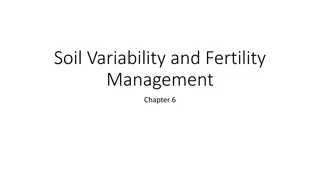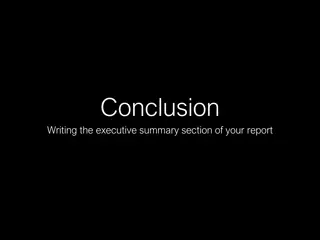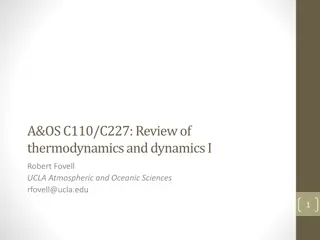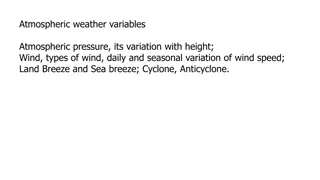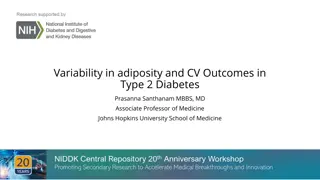Impact of Indian Ocean Dipole on Central Africa Rainfall Variability
Workshop on Indian Ocean Variability and Teleconnections discussed the assessment of the link between Indian Ocean Dipole (IOD) and rainfall variability in Central Africa. The study utilized precipitation data, sea surface temperatures, and dynamic variables to analyze the impact of IOD events on Ce
12 views • 7 slides
Atmospheric Pressure Variations at Different Altitudes
Atmospheric pressure varies with altitude due to the weight of the air column above. This activity explores how Otto von Guericke's experiments with vacuum systems demonstrate the power of air pressure. Theoretical concepts of atmospheric pressure are discussed, highlighting its relation to gravity
3 views • 28 slides
Cutting-Edge Atmospheric Chemistry Modeling Research at Barcelona Supercomputing Center
Conducted by the Atmospheric Composition Group at Barcelona Supercomputing Center, this cutting-edge research focuses on atmospheric chemistry modeling using advanced tools and frameworks like HERMESv3 and MONARCH. The team's approach integrates various modules to study complex processes influencing
0 views • 16 slides
Overview of Low-Cost Sensors for Atmospheric Composition Measurement
This publication provides an insightful overview of low-cost sensors for measuring atmospheric composition, covering topics like sensor technologies, applications in atmospheric sciences and air quality management, and evaluation methods. It emphasizes the importance of not only the technical perfor
2 views • 17 slides
Modelling and Optimization of Quality Attributes in Software Variability
Modelling and multi-objective optimization of quality attributes in variability-rich software is crucial for customizing software functionality to meet stakeholders' diverse needs. This involves addressing conflicting quality requirements such as cost, reliability, performance, and binary footprint
3 views • 34 slides
Soil Variability and Fertility Management
Addressing challenges in crop production involves managing soil nutrients, moisture content, and variability. Precision agriculture techniques offer solutions such as site-specific nutrient management and mathematical approaches for matching fertilizer recommendations. This chapter discusses sources
0 views • 72 slides
Sampling Variability in Statistical Analysis
Random sampling is crucial in statistical analysis to minimize sampling error. Sampling variability occurs due to chance when a random sample is surveyed instead of the entire population. Different units selected can lead to slightly varied estimates. It's important to understand and address samplin
9 views • 31 slides
Central Tendency and Variability in Distributions
Central tendency and variability are fundamental features of statistical distributions. Central tendency, encompassing mean, median, and mode, represents the middle of a distribution, while variability describes the spread of data points. Knowing the effect of distribution shape on these measures he
5 views • 25 slides
Population Genetics: Mutations, Variability, and Evolution
Explore the fascinating world of population genetics, covering key concepts like the history of population genetics, mutation types, measurement of variability, and mutation rates. Delve into the diverse mutations such as substitutions, insertions, deletions, and duplications, along with how these v
8 views • 47 slides
NSF Atmospheric Chemistry Program Overview
The NSF Atmospheric Chemistry Program aims to characterize the chemical composition of the atmosphere, understand chemical processes, quantify fluxes of chemical substances, study natural and anthropogenic causes of variability, and assess impacts on climate. The program supports research through pe
2 views • 6 slides
Atmospheric Composition and Structure
The presentation covers fundamental concepts related to the Earth's atmosphere, including its composition, origin of oxygen, dry and moist layers, standard atmosphere layers, and temperature variations. Key topics discussed include the primordial atmosphere, atmospheric constituents, water vapor dis
1 views • 58 slides
Genotypic Variability in Chilli: Colour, Pungency, and Antioxidant Activity
This study explores the genotypic variability in colour, pungency, and antioxidant activity among different chilli genotypes, highlighting the importance of chillies as a major spice crop in India and various other countries. The research aims to analyze the extent of variability in key parameters s
0 views • 31 slides
GEOS-Chem Atmospheric Chemistry Model Overview
GEOS-Chem, developed by Daniel J. Jacob at Harvard University, is a global model of atmospheric composition used to understand human and natural influences on the environment. The model addresses various atmospheric chemistry issues on different scales, from local to global, and is regularly updated
3 views • 19 slides
Fabrication Variability in Semiconductor Manufacturing
Fabrication variability in semiconductor manufacturing refers to variations in physical characteristics of transistors, impacting their electrical parameters. This variability, whether systematic or random, can lead to performance deviations in digital circuits, affecting power consumption, timing,
2 views • 48 slides
Exploring Variability and Noise in Neural Networks
Understanding the variability of spike trains and sources of variability in neural networks, dissecting if variability is equivalent to noise. Delving into the Poisson model, stochastic spike arrival, and firing, and biological modeling of neural networks. Examining variability in different brain re
1 views • 71 slides
Atmospheric Pressure, Wind Variations, and Humidity in Weather Systems
The atmosphere is composed of various elements like gaseous molecules, water vapor, and dust particles. Key weather variables include atmospheric pressure, temperature, humidity, wind, cloud cover, and precipitation. Atmospheric pressure is influenced by the weight of air above a point, with average
5 views • 17 slides
Addressing the Gap Between Graduates' Skills and Employers' Expectations in Atmospheric Geosciences
The article discusses the skills gap in the atmospheric geosciences field, highlighting key technical and communication skills needed by graduates and postgrads. It explores strategies to bridge this gap through surveys, creative solutions, and innovative approaches like updating degree requirements
3 views • 5 slides
Adapting to Monsoon Variability in India: The Case for Irrigation
This study explores the impact of monsoon variability on crop irrigation in India using an empirical model. It examines changes in crop irrigated areas in response to monsoon variations, focusing on rice, wheat, and sorghum. The research analyzes crop water needs, sensitivity to drought, and irrigat
10 views • 11 slides
Reactive Clocks with Variability-Tracking Jitter in ICCD 2015
Explore the research on reactive clocks with variability-tracking jitter presented at ICCD 2015. The study delves into the cost of variability margins, timing analysis, clock variability comparison between PLL and reactive clocks, and adaptive frequency utilization. Understand the benefits and impli
1 views • 24 slides
Standard Deviation and Standard Error of the Means
Standard deviation measures the variability or spread of measurements in a data set, while standard error of the means quantifies the precision of the mean of a set of means from replicated experiments. Variability is indicated by the range of data values, with low standard deviation corresponding t
6 views • 7 slides
Analysis of Atmospheric Parameters and Transmission at OHP in 2018
This analysis focuses on the atmospheric parameters and transmission at the Observatoire de Haute-Provence (OHP) during 2018, with a specific emphasis on distinguishing between typical winter and summer conditions. The study utilizes MERRA2 data from January to August to examine pressure, precipitab
0 views • 16 slides
Spatio-temporal Variability of Ozone Laminae in Huntsville
Investigating the spatio-temporal variability of ozone laminae in Huntsville, this study by Michael Newchurch and team explores the atmospheric science aspects related to ozone dynamics. The research, presented at the GEO-CAPE Community Workshop in Boulder, delves into the implications of ozone laye
5 views • 24 slides
Future Changes in Atmospheric Rivers in Norway
Research investigates future trends in atmospheric rivers and extreme precipitation in Norway. Findings show increasing frequency and intensity of atmospheric rivers in the Far-Future, particularly during summer, with winter precipitation rising on the mid- and south-west coasts. Utilizing data obse
2 views • 13 slides
Dynamics and Chemistry of the Upper Troposphere: Factors Impacting Interannual Variability
Revisiting the factors driving variability in stratospheric water vapor, this study explores the influence of QBO, CH4, ENSO, and non-linear predictors in forecasting atmospheric conditions. Results indicate the importance of incorporating additional predictors to enhance prediction accuracy.
0 views • 11 slides
Workshop on Solar Variability Effects on Earth's Climate
This workshop, held in Boulder in 2011, explored solar variability and its impact on Earth's climate. Topics included solar influences on the troposphere and stratosphere, mechanisms connecting solar changes to climate, and evidence from paleoclimate records. The event featured sessions on radiometr
1 views • 4 slides
Atmospheric Sciences 101 Atmospheric Sciences 101
Dive into the fascinating world of atmospheric sciences with this comprehensive course. Learn to interpret weather maps, satellite imagery, and radar data. Explore key atmospheric phenomena and their relation to physical principles and laws. Discover how to be a savvy weather consumer by understandi
0 views • 10 slides
Group Analyses in Brain: Effect Size and Variability
Conducting group analyses in brain imaging studies involves examining effect sizes and variability across subjects. This process includes first-level analyses at the voxel level, comparing within-subject variability and effect sizes, and second-level group analyses to assess group effects compared t
3 views • 26 slides
Atmospheric Sciences Course: Winter 2023
Gain an understanding of synoptic systems, dynamical concepts, and weather forecasting in the Atmospheric Sciences 370 course for Winter 2023 with Cliff Mass and Rick Steed. Explore the structure and evolution of weather phenomena, developing essential skills in atmospheric analysis and forecasting
0 views • 6 slides
Variability in Adiposity and Cardiovascular Outcomes in Type 2 Diabetes Study
This research study explores the association between variability in adiposity markers and cardiovascular outcomes in adults with type 2 diabetes, focusing on the impact of intensive lifestyle intervention. Secondary analysis of data from the Look AHEAD trial is conducted to investigate the relations
2 views • 11 slides
Bacterial Genetics: Phenotypic and Genotypic Variability
Explore the fascinating world of bacterial genetics, diving into the phenotypic and genotypic variability of bacteria. Learn about the physical expressions and hereditary constitutions of bacterial cells, including mutations and induced variations that shape their characteristics. Discover how envir
1 views • 23 slides
ERCOT Net Load Forecast Variability Process Overview
Explore ERCOT's process of monitoring and addressing net load forecast variability by assessing weather conditions, procuring additional non-spin resources, and updating forecast variability reports, aiming to maintain grid reliability. Learn about the timeline for triggering additional non-spin qua
2 views • 6 slides
Variability in Pathogens and Mechanisms of Genetic Variability
Explore the concept of variability in pathogens, genetic mechanisms, and the emergence of new genes in response to resistance. Discover how genetic variability occurs in organisms such as fungi and the impact of asexual reproduction on variability. Gain insights into gene flow among plant pathogens.
4 views • 30 slides
Lunar Atmospheric Composition Experiment: Insights into Moon's Atmosphere
The Lunar Atmospheric Composition Experiment (LACE) on Apollo 17 provided valuable data on the Moon's exosphere, gas molecules, and atmospheric dynamics. LACE's ionization process, mass range scans, and data records offer a deeper understanding of lunar atmospheric composition. Discover the impacts
1 views • 11 slides
Sources of Variability in Experiment Design
In research studies, the number of trials conducted can vary based on the sources of variability within and between participants. Social psychology studies focus on variability between individuals, while visual psychophysics studies highlight variability within participants due to attentional factor
2 views • 6 slides
Variability in Experimental Design
Social psychology studies may show variability between individuals, while visual psychophysics studies focus on trial-to-trial differences. In cognitive psychology experiments, variability within and between participants impacts trial collection. Attention plays a crucial role in this task with 126
1 views • 19 slides
Data Summarization Techniques: Central Tendency and Variability Analysis
Central tendency and variability measures play a crucial role in summarizing data. Central tendency involves calculating the mode, median, and mean to represent the distribution's center. Variability analysis focuses on how data spread around an average value, utilizing measures like range, interqua
0 views • 28 slides
Atmospheric Thermodynamics Fundamentals
This lecture covers key concepts in atmospheric thermodynamics, including forms of energy, Earth's atmosphere overview, composition, vertical structure, pressure, temperature, density, and important equations like the hydrostatic and hypsometric equations. Gain insights into the fundamentals of atmo
2 views • 21 slides
Energy-Efficient Timing Error Recovery in GPGPUs
Addressing variability challenges in nanoscale CMOS, this research presents temporal memoization for energy-efficient timing error recovery in GPGPUs. The study explores sources of variability, costs of variability-tolerance, and temporal instruction reuse in GPGPUs. Experimental setup and results a
1 views • 22 slides
Understanding Measures of Variability in Math Class
Explore the concept of variability in math through Mean Absolute Deviation (MAD), the 5-Number Summary, and statistical skills in this week's agenda. Learn how to describe data by its range and answer questions about center and variability. Homework involves finishing classwork and watching a video
0 views • 5 slides
Understanding Atmospheric Thermodynamics: Dry Air, Stability, Buoyancy
Explore the concepts of dry air, stability, and buoyancy in atmospheric thermodynamics through this detailed lecture. Learn about the definitions of dry air, stability of dry air with adiabatic lapse rate, and the role of buoyancy in atmospheric conditions. Dive into the dynamics of potential temper
2 views • 15 slides




